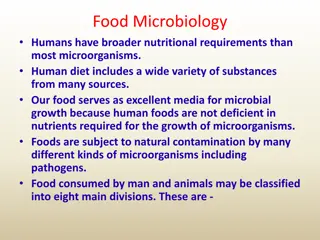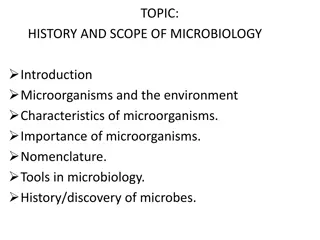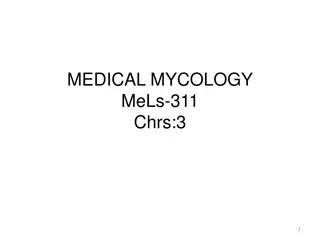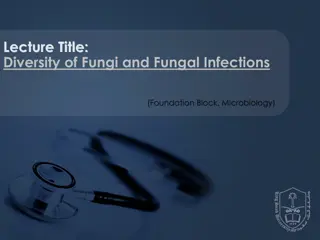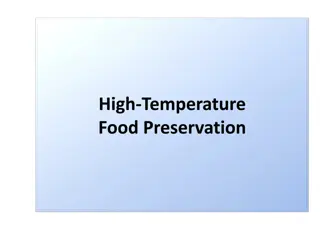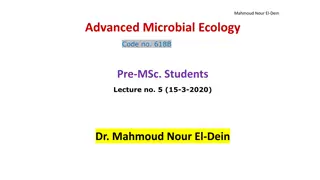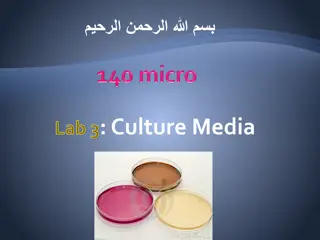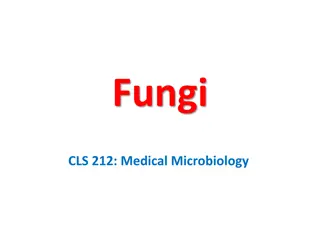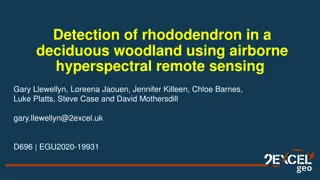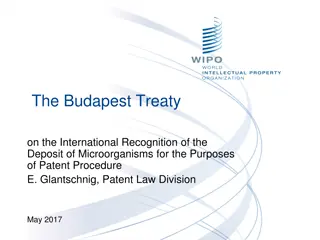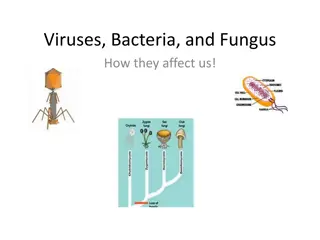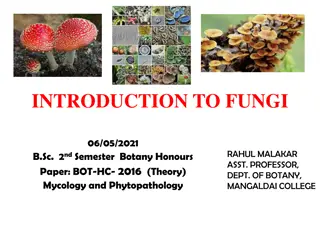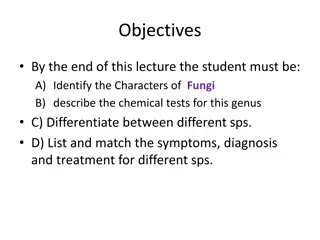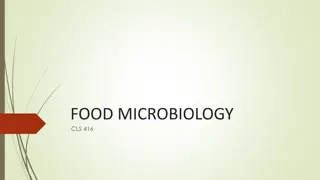Insights into Airborne Microorganisms and Fungi: Implications for Food Safety
Airborne microorganisms and fungi play crucial roles in food microbiology, with various species surviving in the atmosphere despite hostile conditions. Bacteria like Bacillus and Streptomyces disperse through air turbulence, while fungi such as Penicillium and Aspergillus produce spores resistant to desiccation. Understanding their dispersal mechanisms can aid in preventing food spoilage and ensuring food safety.
Download Presentation

Please find below an Image/Link to download the presentation.
The content on the website is provided AS IS for your information and personal use only. It may not be sold, licensed, or shared on other websites without obtaining consent from the author.If you encounter any issues during the download, it is possible that the publisher has removed the file from their server.
You are allowed to download the files provided on this website for personal or commercial use, subject to the condition that they are used lawfully. All files are the property of their respective owners.
The content on the website is provided AS IS for your information and personal use only. It may not be sold, licensed, or shared on other websites without obtaining consent from the author.
E N D
Presentation Transcript
UNIVERSITY OF BASRAH / COLLEGE OF SCIENCE lecture 3 The Scope of Food Microbiology Department of Pathological Analyses
Micro-organisms in the atmosphere The atmosphere is a hostile environment for micro-organisms due to desiccation, sun damage, and oxygen exposure. Many, especially Gram-negative bacteria, die rapidly when suspended. However, some survive and use air turbulence for dispersal, despite none growing or multiplying. Airborne Bacteria Quantitatively determining microbial propagule numbers requires specialized equipment, but a qualitative estimate can be obtained by exposing a Petri dish to air, which often displays a diverse range of colonies.
Airborne Bacteria Bacterial flora is primarily Gram-positive rods and cocci, unless air contamination has occurred. Colonies are often micrococci or corynebacteria, with large white-to-cream colonies of Bacillus sporeforming rods. Small, raised colonies may be Streptomyces or Actinomycetes. Pigments protect microorganisms from sunlight damage, while Gram-positive bacteria's simple cell walls offer protection from desiccation. Bacillus and Streptomyces endospores are particularly resistant to air suspension.
Airborne Bacteria Bacteria are dispersed on dust particles, water droplets, and skin rafts. Aerosols are generated by coughing, sneezing, bubble bursting and liquid impaction. Actinomycetes, particularly Streptomyces, produce dry spores that survive in the atmosphere. They can cause diseases like farmer's lung and geosmin, which can cause earthy odors and off-flavours in potable water and shellfish. Farmyard barns may contain millions of spores per cubic metre, affecting human health.
Airborne Fungi The evolution of terrestrial filamentous fungi can be attributed to sophisticated mechanisms for air dispersal of reproductive propagules. Important food microbiological moulds, like Penicillium and Aspergillus, produce small, unwettable spores resistant to desiccation and light damage, causing significant food spoilage. These spores, small and light, efficiently disperse in turbulent air. Fusarium fungi produce easily wettable spores that disperse into the atmosphere in droplets of water, allowing them to be widely distributed in field crops during wet weather. This mechanism is used for shortterm plant pathogen dispersal. As humidity decreases, Cladosporium spores twist and collapse, becoming the most common in the air spora. These species can form unsightly black colonies on commodities like chilled meat.
Airborne Fungi Fungi, like mirror yeasts, fire their spores into the atmosphere at high relative humidity, allowing them to continue even during dry days. This process is driven by evolutionary pressure to produce macroscopic fruiting bodies, as seen in mushrooms and toadstools. Although we may not be aware of microorganisms in the atmosphere, they play a crucial role in spreading and contaminating food.
Micro-organisms of soil Soil environment is complex, with diverse flora of bacteria, fungi,protozoa, and algae. It is a rich reservoir of micro-organisms, providing strains used in pharmaceutical and food industries. These micro-organisms recycle organic and nitrogenous compounds, but can also be spoilage organisms. Protecting food from dirt reduces the likelihood of inoculating spoilage organisms. Soil is competitive, causing bacteria and fungi to produce resistant structures, such as endospores and sclerotia, which can withstand temperature fluctuations. Such as the endospores of Bacillus and Clostridium.
Micro-organisms of water Aquatic environments are the largest part of the biosphere, with fresh water and sea containing various micro-organisms adapted to their habitats. Marine bacteria, oligotrophic psychrophiles, require sodium chloride for optimal growth. Fish caught from cold water in the open sea have a bacterial flora reflecting their environment, containing predominantly psychrophilic and psychotrophic species. These organisms can break down macromolecules and have doubling times as short as ten hours at refrigeration temperatures.
Micro-organisms of water However, during handling, natural flora may be contaminated with man-associated organisms. The seas around the coasts are influenced by terrestrial and freshwater microorganisms and human activities, which have a detrimental effect on coastal waters. Many shellfish grow in polluted coastal waters and feed by filtering out particles from large volumes of sea water. Waters contaminated with sewage can contain enteric organisms from infected individuals, which can cause severe diseases like hepatitis or typhoid fever.



